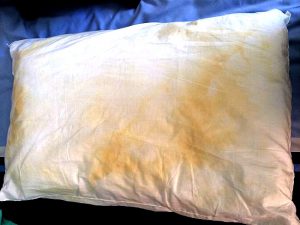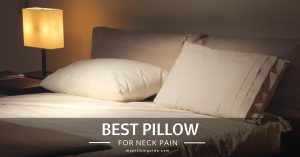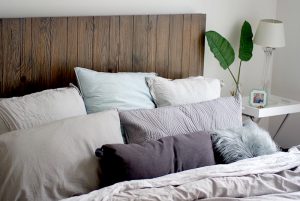Sleeping with or without pillow

Hello friends! I’m here today to shed some light on a very important topic – pillows and your health. Now, some people and they are medical experts at that, say definitively that pillows are bad for you because they misalign your neck and spine into unnatural positions, causing you pain and an unrestful sleep. Some doctors also believe that pillows actually contribute to bad posture.
Not only that, other health professionals think that pillows contribute to wrinkles and facial lines, which is definitely not good news for us ladies. But I will tackle pillows and wrinkles in my next article, since a whole bunch of anti-wrinkle pillows has emerged in the market, and I wanted to find out if they are worth the investment. As a woman, I want to stay as wrinkle-free for as long as possible!
If you think that you would be better off without a pillow, this article not only makes a good argument for saying goodbye to them completely, but it also gives you a step by step process to train yourself how to sleep without them.
Now, this would be extremely difficult for me, because I really love my pillows – the down pillow under my head and the sausage-shaped body pillow I hug at night. Although I only use two, I have five pillows all in all on my bed, making me a serious pillow girl. The others are for when my boyfriend comes to visit, and plus they just make my bed really pretty and inviting. So, pillows serve a decorative function, too.
And while I do understand where the medical experts are coming from, I also know that for people like me, pillows have become an important part of our comfort at night. We’ve gotten so used to having pillows that taking them away would most likely take away part of our sleep as well.
So, what should we do?
I started to research to look for a final answer, and let me take you along on a journey of what I’ve found.
When your pillow can be bad for you
1. Numbers matter
Have you ever seen in a movie or television show, the main character’s bedroom is shown and he or she is lying or leaning back on a stack of two or even three huge, fluffy-looking pillows? To be honest, with all the research I’ve done on pillows, I’ve looked at those scenes and wondered, how can they sleep on so many pillows? Won’t they wake up with a stiff neck and a sore back? Aren’t they doing very serious damage to their spines?
I’ve said it once and I’ll say it over and over again… our necks, backs, and spines need to be in alignment for us to stay pain-free and in good health. This is the secret to a good sleep every night, having an aligned spine. You’ll save yourself not only from pain but also possibly from thousands of dollars of surgery one day if your spine stays in good alignment.
Can you imagine how hard it would be for your neck muscles to work well, even in your sleep, when your chin is forced too far forward because of too many pillows? Or maybe for your arm muscles, when you sleep on your side and, because of the height of your pillows, your arm is twisted far away from your body? What about stomach sleepers who lie on many pillows, forcing their necks to arch back all night?
None of this will contribute to a good sleep. Too many pillows cause what doctors call “forward head posture” which results in tension in the neck muscles, problems in the shoulders in arms, as well as headaches. What’s worse is that you could even lose some movement in your neck if you damage your muscles too much because of forward head posture. This should be a good motivation to get rid of all excess pillows on our beds, and to make sure we sleep on the right pillow that keeps our spine aligned, whether at home or when we travel.
2. How old is your pillow anyway?

I think we have all been guilty of keeping our favorite pillows longer than they’re good for, right? Just because we associate them with comfort and good sleep, we’ve refused to get rid of pillows that are way past their prime. I remember that when I was a child, I kept my pillows for as long as I could, even when my mother was telling me to say goodbye to them.
How do we know it’s time to get rid of our pillows?
I would say, give your pillow a two-step test.
- Step one: remove the cover and look at the pillow itself. Is it no longer white (or the original color it came in) and is now stained? I’m not talking about pale yellowish stains that will come out in a good washing with hot water and Borax, but you know those old stains that have actually turned brown in their outlines? If your pillow has something printed on it, have you let it get so old that you can barely read the print anymore? And how does it smell – still okay or old and musty? If your pillow is definitely showing signs of age, and it takes at least a couple of years to get it in this state, then it’s time to say bye-bye to it, no matter how much you love that thing.
- Step two: fold it in half, and lay it on a flat surface. If it goes back to its original rectangular shape on its own, maybe it still has a chance to be useful. If it stays folded even after you let it go, well, it’s time to let it go.
Well, why are old pillows so dangerous, anyway? The truth is, the older the pillow is, chances are that it contains fungi and dust mites. And since your pillow is close to your nose and airways for many hours at a time, it can pose a danger to your health, especially if you and/or your partner or kids have allergies.
So, should we get rid of pillows completely?
Hang on, not so fast.
Some doctors actually say that not having pillows could be just as bad as having too many of them. Why is this so?
Well, for one thing, very many of us already have a measure of “forward head posture,” especially in these times where we sit for many hours at a desk, leaning forward over our keyboards or computer screens. (Guilty!) And the older we get, the more pronounced this slightly forward head posture gets.
Now, nighttime sleep is the when we can balance this out. If you don’t have a pillow, there is a possibility that your neck goes too far backward, a position you’re no longer used to, since having forward head posture has become your new normal. We actually need pillows to prop our heads and necks up so that our spine is aligned with them. Therefore, the right pillow for you allows your body not only to rest but to get realigned.
Having said that, there are people, and again, medical experts, who will still say that going without pillows completely is better, especially for your neck and back. While this may work for many people, it’s not a guarantee that it will work for you.
The bottom line: There are no hard and fast rules when it comes to pillows. The wrong one, or sleeping on too many or on ones that are so old that they’re infested with bugs, can definitely harm your health. But the right pillow can contribute to your health and a general sense of well-being since it will give you a restful sleep at night.
So how do you choose the right pillow for you?
This is a topic that we have covered before, but let me get into it in a little more depth, since now I can give you additional information from medical experts.
- In choosing a pillow, take your time. Don’t be afraid to spend at least a quarter of an hour examining each pillow, and take more time if necessary. Remember that you will be spending one-third of each day for the next two years with this thing under your head, that’s a lot of hours combined. Come on, if you do your due diligence before you buy a car, and spend time test-driving it as well, won’t you do the same with a pillow that you’ll spend more time with?
- Lie on the pillow for a few minutes to get a real feel for it. Thank goodness that in department stores pillows and mattresses are sold in the same area, and so you can fully lie down. Don’t be embarrassed if people stare! I bet they were wishing they had the guts to do the same thing. Just think of it this way: your health and the quality of your rest depend on your pillow, so buying one should not be done hastily or lightly.
- Take a friend with you to check if your spine is aligned. Having a friend along is good because they will check for you that your head and back are in a straight line. If you are a back sleeper this is fairly easy – anyone should be able to tell if your head is too far forward or back. But for side sleepers, which most of us are, use the nose-to-bellybutton technique. Have whoever is with you check to see if your nose and bellybutton are on the same level. If this is so, the pillow is a good fit for you.
- Remember that pillows are not one-size-fits-all. Your height and weight are determining factors in choosing a good pillow for you. Unfortunately, just because a certain pillow worked in eliminating the neck pain for a friend, it doesn’t follow that you’ll have the same results.
- Look for pillows with a money back guarantee if you buy online, or check out the exchange policy if you buy pillows at a store, especially if you’re going for the high-end more expensive brands that cost more than a hundred dollars or euros. It’s possible that you won’t experience the full extent of how your pillow works for you until you’ve spent not just one night but several nights in a row. It’s also possible that the pillow that worked so well for you in the store doesn’t quite have the same effect when you’re back in your own bed.
Let me share something that helped me understand how important spinal alignment is. In the video below, Dr. Mandell says that whether you have a pillow or not is not the question, it really is all about how you use your pillow. As a side-sleeper myself, it was interesting to hear him say that in this position, not having a pillow could be really dangerous for your spine. The diagrams he shows in the video of how a pillow with the right height helps side-sleepers’ spines stay aligned helped me visualize as well.
If this is something that’s important to you, I think you’ll find an article that I wrote about pillows and neck pain to be very helpful for you.
I’d also love to hear more about your stories. Have you tried to sleep without a pillow, and found that it worked for you? If you have, tell me in the comments below!
By the way, if you need a rundown of Best pillow for neck pain – check out my article:






